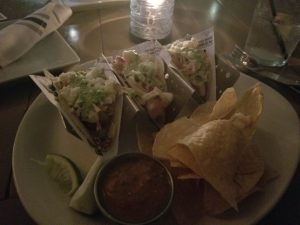Blackened Catfish and Shrimp
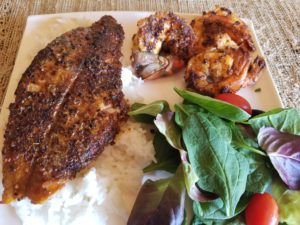
What does “Blackened” mean anyway?
To blacken fish (or meat) is a very simple process. The method is described by Cajun Dictionary of Louisiana Foods as follows:
To blacken, the chef coats the fish or meat with spices and quickly sears it in butter in a cast iron skillet. The goal is to get a crunchy coat. It is not supposed to be burned, over-charred or excruciatingly spiced with pepper.
Who invented this simple yet delicious method of cooking?
Chef Paul Prudhomme is credited to have invented the blackening technique and is also known primarily for fusing Cajun ingredients with classic Creole dishes. Although Prudhomme was from Louisiana, blackening fish and meat dishes was not a Cajun cooking method, but a technique Chef Paul made up (Troeh, 2015). Some people have asked me what the difference between Cajun and Creole is.The simplest difference is that Creole dishes use tomatoes while Cajun food uses mixtures of bold spices. Actually, Creole and Cajun are two distinct cultures (Ducote, 2017). The word Cajun is derived from the term les Acadians, which describes French colonists who have settled in Canada, the region of Acadia, which is present-day Prince Edward Island, Nova Scotia, and New Brunswick (Ducote, 2017). After the Acadians were removed by force during the British conquest in the early 1700s, they eventually settled in a region of Lousiana, presently known as Acadiana (Ducote, 2017). Creole, on the other hand, describes a people born to settlers from French colonial Lousiana, primarily New Orleans. During the 18th century, Creoles were descendants of the Spanish and French upper-class and over time, the term grew to comprise native-born slaves of African ancestry and “free people of color” (Ducote, 2017). The term French Creole commonly describes European ancestry born in the colony, while the term Louisiana Creole describes people whose ancestry is of the mixed race (Ducote, 2017).
Why I chose Blackened Catfish and Shrimp as my cookbook entry
Growing up with the privilege and honor of being surrounded by family, friends, and lots of food is something I will always cherish and do not take for granted. Since I am the daughter of a chef and baker, my family has always enjoyed a variety of dishes as well as pastries that have been made with lots of love throughout the years. Interestingly, my father is the one who, for the most part, taught my mother how to cook. Seeing that my mom is Italian, it is still interesting to me that she never wanted my grandmother to teach her the traditional Italian recipes. I wished she had learned the secret recipes to pass them on to me, but that is not the case and, regrettably, my grandmother passed away when I was just a little girl. However, my father, whose dishes and desserts we thoroughly enjoyed not only cooked traditional Mexican food but American, Italian, and a few Asian dishes too. The only food he did not make nor eat was fish. After having a “terrible” experience with fish when he was young he was unable to eat, cook, or smell any type of fish thereafter. As a result, my sisters and I did not know what we were missing while growing up! Although we went out to dinner often I never ordered fish until I became a teenager. The rest is history. Seafood is one of my favorite dishes to eat and make. However, out of respect for my father, I would not order fish while dining out with him which I did not mind because his presence at the table was what mattered the most to me.
Unfortunately, it was not until he became ill several years ago that I asked, well, more like begged him to start eating healthier. One of my requests was for him to start eating fish in replace of so much red meat and junk food. At first, he would not even consider the idea so I tried getting him to take fish oil pills and other vitamins. Reluctantly, he did but his fish oil days did not last long. I believe in order to keep me from annoying him further, he finally agreed (after much struggle) to start eating fish if the “flavor and smell could be disguised.” I knew he could have made exceptional seafood dishes if he had tried but he never had the desire. So in my quest for spices and recipes to mask an intolerable dish, I was able to try a variety of seafood dishes to find one he would enjoy and include in his new eating plan.
My father had always taken such excellent care of my family and me, so I was more than honored to cook for him and do whatever I could to help him on his road to recovery. So I began cooking with a variety of fish including salmon, light tuna, halibut, trout, and catfish. I also incorporated a variety of herbs, citrus, and spices that are healthy that I thought would help minimize the fishy taste. When I stumbled across a technique on how to blacken fish with spices I immediately bought a cast iron skillet to test it out. Thankfully, the technique combined with the right spices and fish was a success. My dad finally began eating fish as part of his nutritional plan. One of the dishes he liked was blackened catfish and shrimp, although, he also enjoyed the same seasoning on trout and halibut. I would also bake his fish often and use olive oil instead of light butter and often paired his food with fresh vegetables. The following dish is significant to me because of my dad. I found this recipe in a cookbook I love called Famous Dave’s. The book caught my attention solely because of its title as my dad’s name is David and most everyone refers to him as Dave. Since my father’s passing three years ago, I have made this dish (using above-mentioned fish as well) on his birthday for my family to enjoy and as a reminder of what a stubborn and wonderful man we had among us all those years.♥
It amazes me how something as simple as a plate of food can have so much significance. I think about the words spoken by Roy Choi when saying, “Sometimes, in the deepest of moments, there are no words. There is only food. There is a bowl of rice. There is kimchi. Broiled fish. Soups and noodles. Chopsticks and the newspaper. The only things that truly communicate forgiveness and repair a broken soul.” (Choi, 2013, p. 176). These words deeply resonate with me. They articulate my thoughts on food when thinking of my father. Many people have asked what made his food so good. I am convinced that unconditional love was his signature ingredient in every dish and dessert he made. Not only do I cherish all the meals he made for me and my family for so many years, but being able to cook for him as well as serve him has been a great honor. I am truly grateful.
Catfish nutrition
A 3-ounce serving of wild freshwater catfish cooked using a dry-cooking method provides approximately 89 calories, 15.7 grams of protein, 2.4 grams of fat and 0.6 grams of saturated fat and is free of fiber and carbohydrates. The protein, fat and saturated fat contents represent about 31 percent, 4 percent and 3 percent of the daily value, respectively, according to healthy eating (Gray, n.d.).
Shrimp Nutrition
The nutritional values of “Shrimp” per 100 grams:
| Total Calories | 85 |
| Protein | 20.1 g |
| Fat | 0.4 g |
| Carbohydrate | 0 g |
| Nutrients | Amount |
| Calcium, Ca | 64 mg |
| Copper, Cu | 0.39 mg |
| Iron, Fe | 0.52 mg |
| Magnesium, Mg | 35 mg |
| Manganese, Mn | 0.03 mg |
| Phosphorus, P | 214 mg |
| Potassium, K | 264 mg |
(Sewlani, 2017)
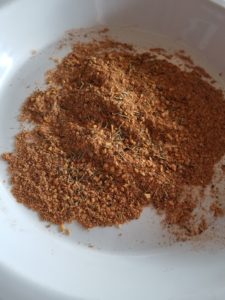 |
Prepare the seasoning and dredge fish and shrimp in herb/spice mixture
Ingredients:
½ cup paprika
6 tablespoons kosher salt
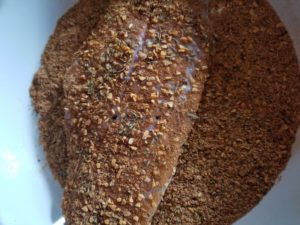
¼ cup coarse ground black pepper
3 tablespoons dried basil
3 tablespoons file powder
2 tablespoons garlic powder
2 tablespoons dry mustard
2 tablespoons onion powder
2 tablespoons dried oregano
2 tablespoons cayenne
2 tablespoons ground white pepper

2 tablespoons dried thyme
Ingredients:
1 cup Cajun Dynamite Dust
4 – 6 catfish fillets
12 peeled shrimp (approximately 26-30)
2 tablespoons unsalted butter
Cajun Shrimp with homemade seasoning
Directions:
For the Cajun seasoning, mix all the ingredients in a bowl.Use as a rub for any blackened dishes. For the blackened catfish (or fish of your choosing) and shrimp, place 1 cup of seasoning on a flat plate or round dish. Coat each catfish fillet and shrimp with the seasoning mixture. Using your hands, rub seasoning into the fillets and shrimp. Heat a cast-iron skillet over high heat until very hot; add butter. Heat until sizzling then add catfish. Pan-fry until blackened on both sides (approximately 4 – 5 minutes per side), turning only once. (Unless you have high-draft commercial-type exhaust hood, pan-fry the catfish as directed over hot coals on a grill outside.) For unused seasoning, store in an airtight container in a dark, cool environment (Anderson, 2004).
I usually make this dish with a side of red beans, white rice, and a salad. This recipe is also great for fish tacos, salads, and sandwiches. Also, if your taste buds are a bit more on the sensitive side, you can try reducing the cayenne by half. You may also squeeze some lemon juice over fish if preferred. Yield: 4 main dish servings and 2½ cups seasoning (Anderson, 2004).
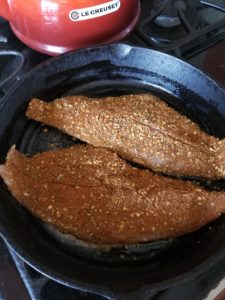
This is quick and simple but a delicious seafood dish!
Catfish health benefits
Fish is known to have many health benefits. According to Harvard School of Public Health, “fish and other seafood are the major sources of healthful long-chain omega-3 fats and are also rich in other nutrients such as vitamin D and selenium, high in protein, and low in saturated fat.” Consuming up to an average of two meals per week of low mercury fish and shellfish are part of a healthy diet as it is good for the blood vessels as well as the heart. The same article describes the importance of eating low mercury fish which include catfish, salmon, and pollock.
There are over 3000 species of catfish that can be found on all continents except on the continent of Antarctica. As one of the most farmed types of fish (their meat is consumed as a delicacy around the world), catfish helps with meeting your protein needs and assists in boosting your intake of healthy fats, vitamins, and fatty acids. Although catfish has been researched and found to have some disadvantages to health along with other types of fish, I have listed below the benefits of incorporating fish, including catfish, into a healthy diet (Health Benefits and facts of Catfish, 2017).
- Great for your heart
- Clearing the vessels
- Joint benefits
- Beneficial for eyes
- Essential nutrients
- Protect Lungs
- Helps Lose Weight
- Fights Depressions
- Good for Skin Health
- Good for Nervous System
- Digestive health
- Boost your brainpower
- Good for the formation of bone and teeth
| Major nutrients | Vitamin B-12 (165.83%) Lysine (71.71%) Tryptophan (71.59%) Isoleucine (70.16%) Threonine (67.67%) |
Shrimp health benefits
As mentioned above, low levels of mercury should be considered when choosing your next seafood dish. Along with catfish, light tuna has relatively low levels of mercury, as well as other fish, such as wild and farmed salmon and shrimp, contain very low levels of mercury. Health benefits include:
- May lower risk of Alzheimer’s Disease Research has revealed that foods rich in omega-3 fats such as shrimp have the ability to improve cognition, mood and concentration levels. A study compared the fat content of shrimp to egg and it was found that shrimp has a lower fat and cholesterol content (Sewlani, 2017).
- Boosts Immune System Astaxanthin is a natural and potent antioxidant present in shrimp. It acts as an immune system stimulator and reduces the level of oxidative stress. It works through different pathways to support a healthy immune function. Astaxanthin increases the production of antibody-producing cells in the body that fights against disease-causing microbes in the body. It decreases the damage caused to the DNA and thus protects it (Sewlani, 2017).
- Anti-Cancer Properties
Research has found that carotenoids and PUFA (Polyunsaturated Fatty Acids) present in shrimp exhibit anti-cancer properties. Astaxanthin is a very important carotenoid present in shrimp that possesses antioxidant properties. It kills the cancer cells and prevents its spread to other parts of the body. It further enhances the effect of chemotherapy and helps in the treatment of cancer. PUFA also reduces the production of free radicals and reduce the risk of developing tumors. Therefore, shrimp can be useful in the treatment and management of cancer (Sewlani, 2017). - Age-Related Macular Degeneration (AMD)
AMD is a disease in which the macula of the eye is deteriorated. This further blurs the vision and may even lead to vision loss. Research has found that shrimp contains a compound which helps in the treatment of AMD. Astaxanthin lowers free radicals and relieves eye fatigue too (Sewlani, 2017).
References
Anderson, D. (2004). Famous Dave’s: Backroads and Sidestreets. Minneapolis, MN. Famous Dave’s Foundation.
Blackened. (n.d.). In Cajun Dictionary of Louisiana Foods. Retrieved from http://www.cajun-shop.com/cajun-dictionary.htm
Choi, R. (2013). L.A. Son. New York, NY. Harper Collins Publishers.
Ducote, J. (2017). Cajun vs. Creole: What’s the difference? HuffPost. Retrieved from https://www.huffingtonpost.com/Menuism/cajun-vs-creole_b_1447822.html
Fish: Friend or Foe? (2018). Harvard T.H. Chan. School of Public Health. Retrieved from https://www.hsph.harvard.edu/nutritionsource/fish/
Gray, C. (n.d.). Catfish and Health. SFGate. Retrieved from http://healthyeating.sfgate.com/catfish-health-4104.html
Health Benefits and facts of Catfish. (2017). Retrieved from https://www.healthbenefitstimes.com/catfish/
Sewlani, S. (2017). Health Benefits of Shrimp. Medindia. Retrieved from http://www.medindia.net/dietandnutrition/health-benefits-of-shrimp.htm
Torpy, J.M., Lynm, C., Glass, R. (2006). Eating fish: health benefits and risks. JAMA, 296(15). http://doi:10.1001/jama.296.15.1926
Troeh, E. (2015). How Chef Paul Prudhomme invented cajun-creole fusion food. NPR. Retrieved from https://www.npr.org/sections/thesalt/2015/10/09/447098722/chef-paul-prudhomme-will-live-on-through-his-restaurants-spices-and-books

 One of the many foods that are symbolic to me is cinnamon rolls. I have fond memories of eating freshly baked cinnamon rolls dripping with cream cheese frosting many mornings before school throughout my childhood.
One of the many foods that are symbolic to me is cinnamon rolls. I have fond memories of eating freshly baked cinnamon rolls dripping with cream cheese frosting many mornings before school throughout my childhood.
